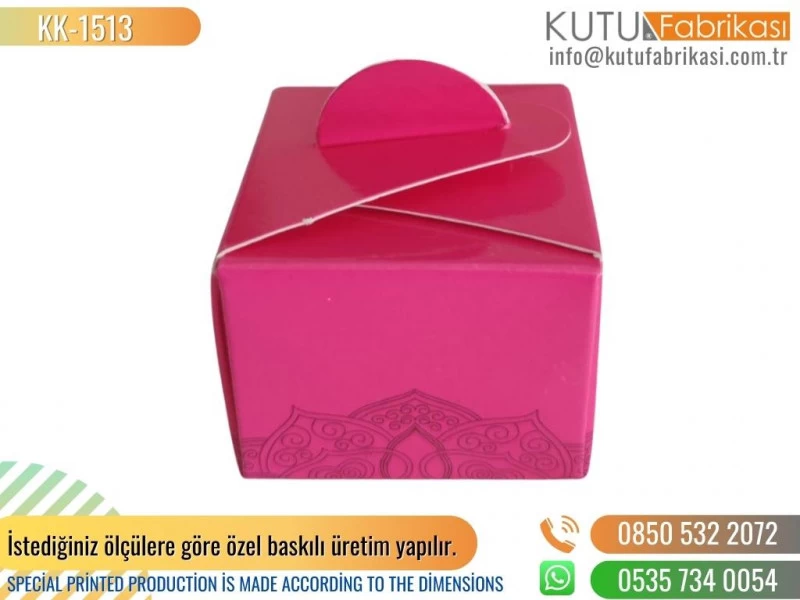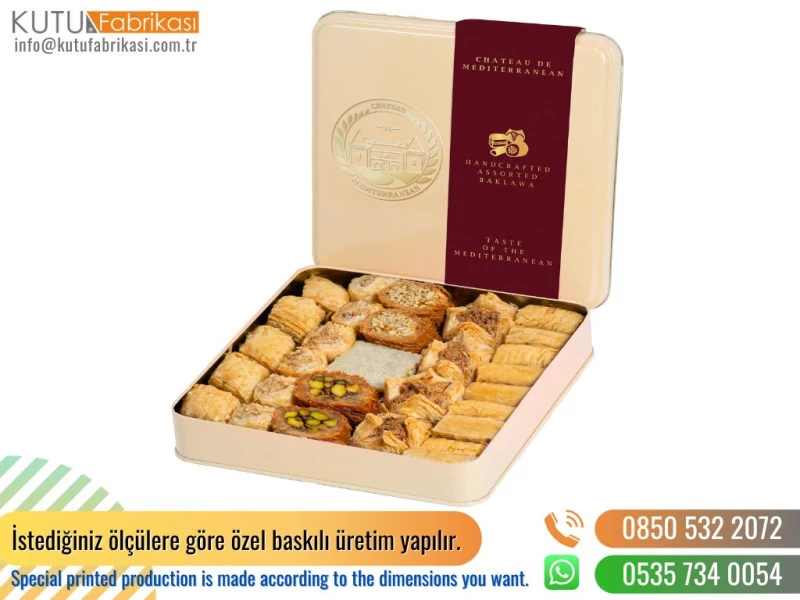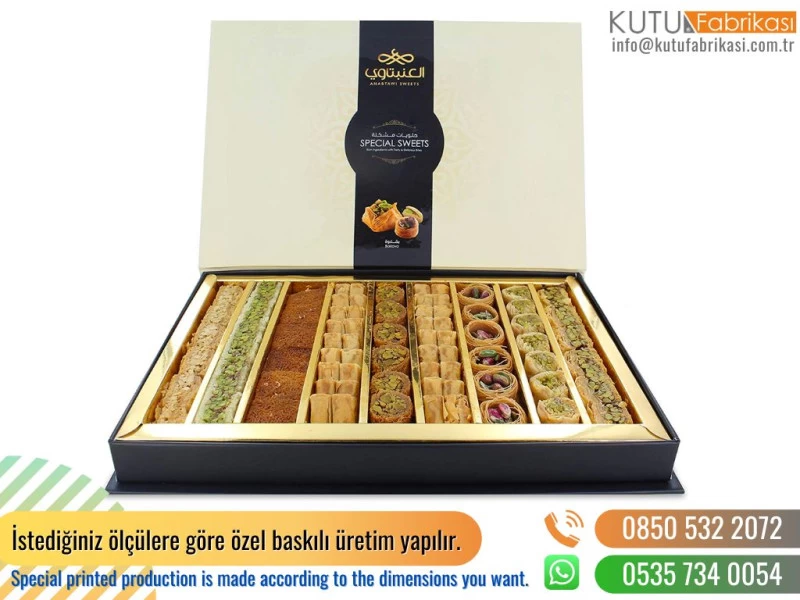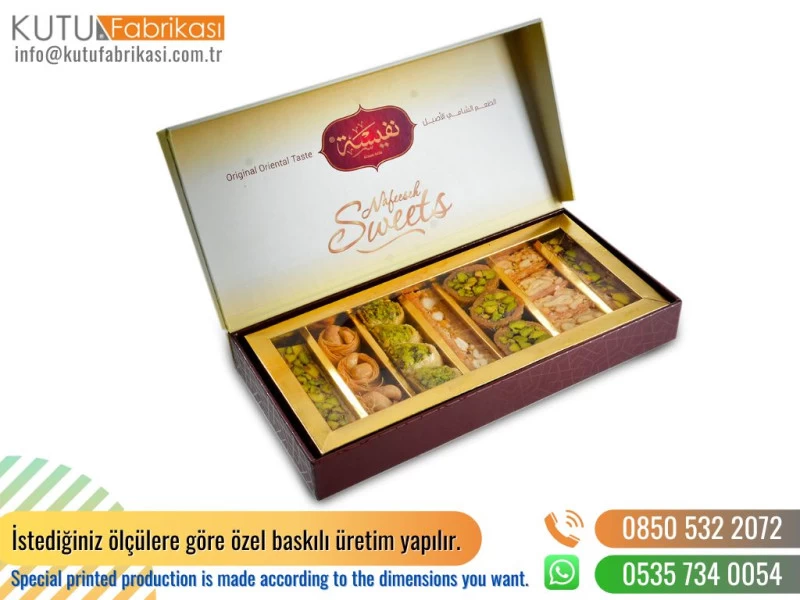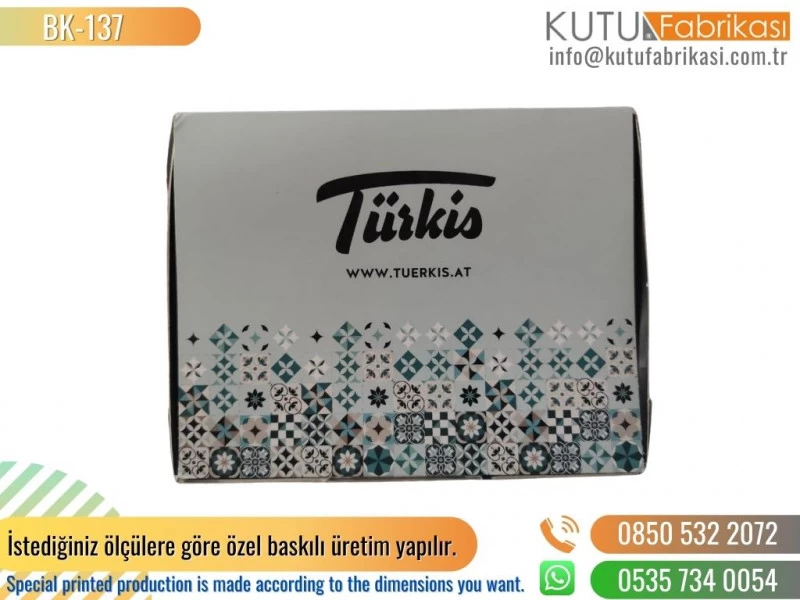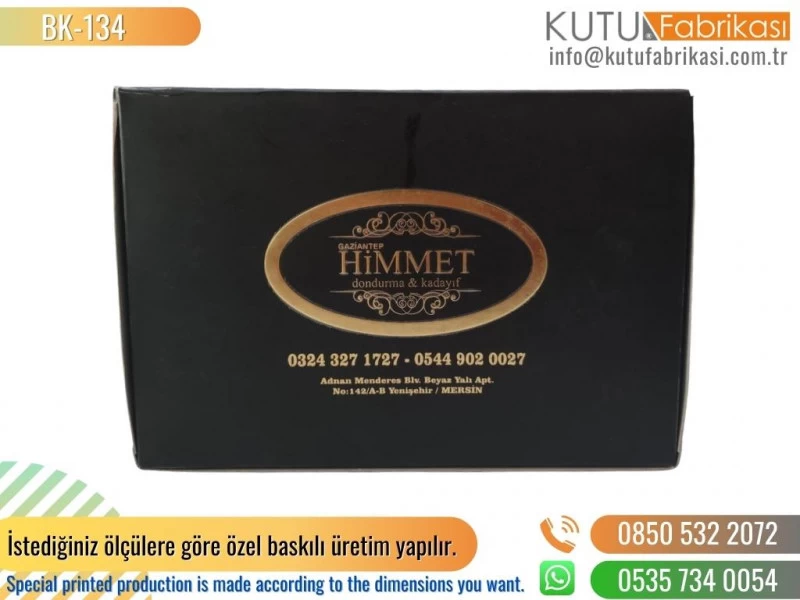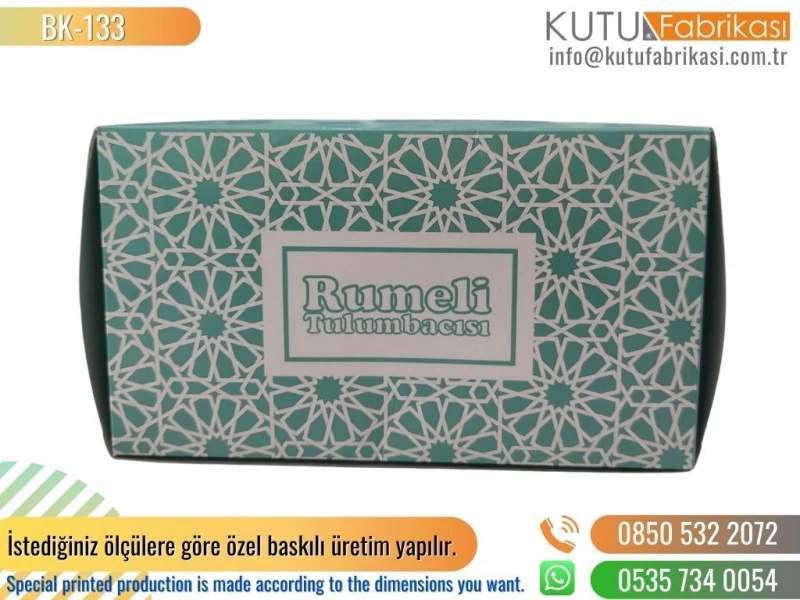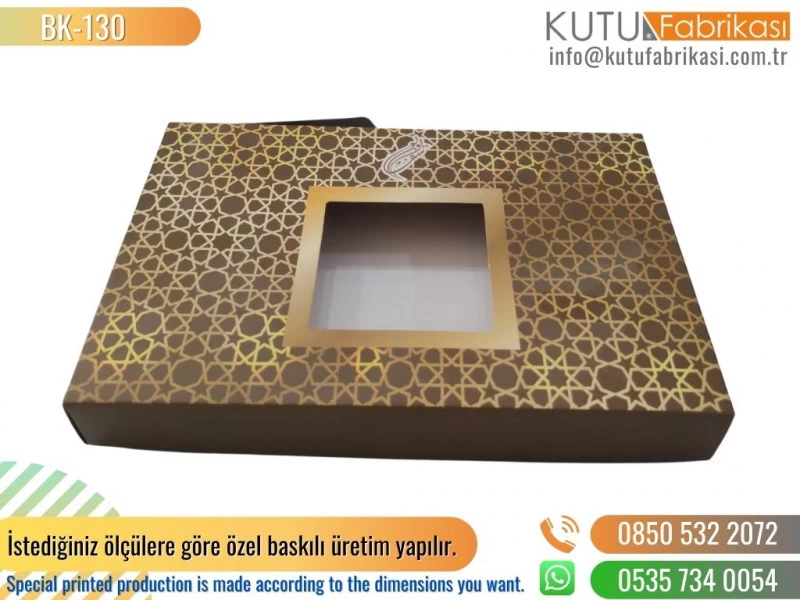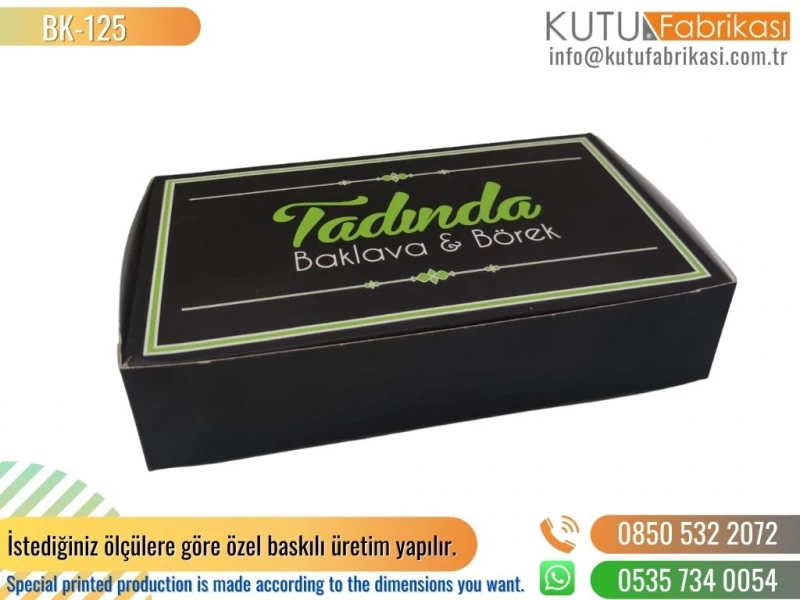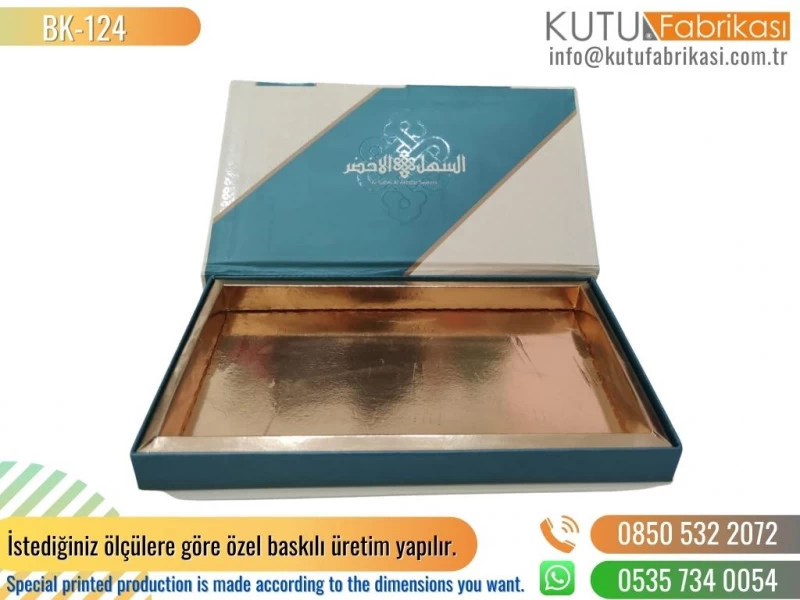Baklava Boxes (32)
Baklava Box Manufacturing
We are pleased that you have stepped into our company, which is heat-proof, resistant to impacts, does not tear easily, and most importantly, ensures that the baklava is well preserved. These boxes, which appeal to the eye as well as the palate, do not threaten your health and are environmentally friendly. Your business will provide development with the boxes that you decide and produce by us. Our boxes will create a quality impression on your customers with their creative design and elegance.
What are Baklava Boxes?
Baklava boxes are usually boxes that contain sherbet baklava, which protects it and keeps its syrup. These boxes, which are not limited to only baklava, include pancakes, Turkish delight, tulumba, kadayif, dry cake, etc. Desserts are also included. Being aware of this, we take your orders carefully and prepare the production with the same care in order to provide you with the best service. Our main goal in baklava boxes is to ensure the durability and health of the box rather than design. Don't let this statement make you think that design will be put in the second place, because the reason why we put durability and health in the forefront is because other manufacturers in the market do not pay attention to this. We are in favor of not threatening your health with the boxes in which you will put food.
How Are Baklava Boxes Made?
Baklava boxes are made according to your budget and request. For your boxes that you have decided on the design and size, we start production after receiving your order. The boxes whose size is decided are cut with the cardboards used according to the desired strength level. Afterwards, we add or do not add the tangible part for our box that you have decided to design, again here your request is in question. After this stage, the boxes sent to print are printed with your logo and slogan and made ready for you. The boxes prepared as special orders suitable for all your small and large companies will represent you in the best way by not exceeding your budget.
Where Are Baklava Boxes Used?
Baklava boxes; in bakeries, cafes, restaurants, markets, online shopping, at home, etc. used in places. Baklava, which is eaten during the holidays in our culture, can be found in every place you can think of. While buying that baklava, which the consumer enjoys very much, to eat at home, the box should also whet his appetite. As long as we manufacture your baklava box, the days when all your customers will be enchanted are at the door!
Dimensions of Baklava Boxes
Since the weight of each baklava box will be different, it would not be right to give you a clear size here. You determine the number and dimensions of the baklava boxes we receive on special order, and we ensure your production in a way that best represents you. For example, the weights of a customer who will buy baklava for their guests during the feast and your customer who will buy baklava for their nuclear family will not be the same. After you create the dimensions according to your customer potential, you can be sure that we will manufacture the best box for your company.
Choosing the Perfect Baklava Box for Your Delicacies
When it comes to presenting and preserving sweets, baklava boxes are as essential as the dessert itself. Not only do they protect the delicate layers of pastry and nuts, but they also add an element of elegance and tradition to the experience. Whether you are a professional baker or simply someone who takes pride in their culinary creations, selecting the right baklava box is a crucial decision.
Material Matters: What’s Your Baklava Box Made Of?
The choice of material for your baklava box can have a significant impact on the freshness and overall appeal of your sweets. From cardboard to luxury wooden, metal, or velvet finishes, each material offers its own benefits. Cardboard boxes are budget-friendly and recyclable, while premium materials like wood and metal provide a more sophisticated presentation and durable structure.
Design and Customization: Personalize Your Packaging
Your baklava box is not just a container but a reflection of your brand. Custom design options like logos, colors, and patterns help you stand out in a competitive market. Whether you prefer a classic look or want to make a bold statement, personalizing your boxes can make all the difference in captivating your customers’ attention.
- Materials ranging from cardboard to plush velvet
- Custom designs for brand differentiation
- Variety of sizes and shapes for all needs
- International shipping for worldwide business expansion
Frequently Asked Questions About Baklava Boxes
Let's address some common inquiries that might tickle your curiosity about baklava boxes.
How Do I Choose the Right Size Baklava Box?
Consider the quantity and dimensions of your baklava. For personal gifts, smaller boxes are intimate and convenient, while larger containers serve well for parties and corporate events. It’s vital to ensure the pastry fits snugly to prevent movement during transport.
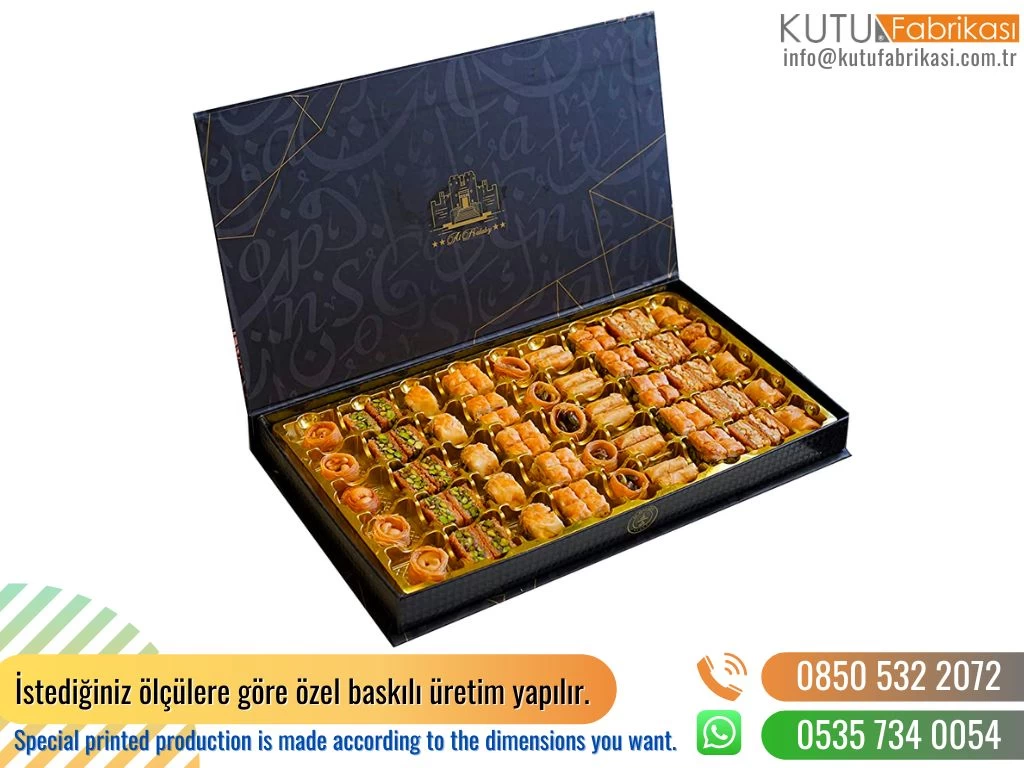
Can Baklava Boxes Be Eco-Friendly?
Yes, many bakeries are now opting for eco-friendly materials like biodegradable cardboard and recyclable plastics. This not only helps the environment but also appeals to eco-conscious consumers. Think about this, have you ever chosen a product based on its eco-friendly packaging?
Are Custom Designs More Expensive?
Custom designs can be cost-effective when ordered in bulk. While they may carry a higher initial cost than standard designs, they play a pivotal role in brand recognition and customer loyalty, potentially boosting sales.
Is International Shipping for Baklava Boxes Worth the Cost?
Expanding your reach to international customers can significantly increase the marketability of your products. While shipping costs can be substantial, the investment in global branding might just be the push your business needs.
Did You Know?
An intriguing fact about baklava is that it dates back to the Ottoman Empire, which makes the packaging not just a practicality but a carrier of history and tradition. Presenting baklava in a high-quality box not only enhances the experience but also pays homage to its rich cultural heritage.
When contemplating the ideal choice for your premium baklava boxes, think about the message you want to send to your recipients. Is it luxury, tradition, sustainability, or maybe all three? Remember, the right packaging is as sweet as the treat inside and can turn a simple dessert into an unforgettable experience.
A8 paper sizes; 52×74 mm
A7 paper sizes; 74×105 mm
A6 paper sizes; 148.5×105 mm
A5 paper sizes; 210×148.5 mm
A4 paper sizes; 297×210 mm
A3 paper sizes; 420×297 mm
A2 paper sizes; 594×420 mm
A1 paper sizes; 840×594 mm
A0 paper sizes; 1188×840mm
Cardboard product labels, prices and features of products can be defined as informative cards containing Product labels placed in a visible place on products aim to inform the customer directly about the price of the product.
Product tags are of great importance in increasing brand awareness and highlighting the brand image. Poor quality printed product labels damage the image of the brand. With its diverse labels, quality designs and materials, it appeals to all companies and brands. Labels, which are usually found in clothing, are visible for long periods of time and the labels stand out every time the clothing is worn. Labels are used for brands to create a unique identity and display their products within the existing brand variety.
Packaging is the garment of the product, buying the consumer process and must have all the necessary beauty of the store. The choice of the right and effective packaging material is as important as the packaging design: attractive packaging with good looks, designed with colors selected according to the nature of the product, consistent texts and shapes have a positive effect. on the consumer. is an important tool for reflecting and dialogue with the consumer. Almost the language of the product. The effectiveness of this language ensures positive results from the doctorate. If the consumer who goes to the market can buy the product in the shopping bag without putting it back, the packaging has a great effect on this. There is no doubt that a good packaging alone cannot be combined with a bad product. A quality product alone can increase your sales with poor packaging. The graphic design of the packaging, like any other advertising issue, is the responsibility of the graphic designer. When the product is presented to the consumer, it should have appeal and impact and be understood everywhere. In the packaging of each product, the relationship between the product and the external elements should be good. It has a strong visual impact and creates a positive image in the consumer's mind. The choice of color on the packaging is a serious matter, because the product influences the thoughts and feelings of the potential buyer, encouraging him to buy. Colors are an important factor in any design. Although variable, the psychological effect of each color is different, for example; Warm colors create the effect of joy, vitality, movement and desire.
Graphic design, a campaign, announcement, Announcement is the development of the message in the digital environment and the realization of multiple designs such as information and warning signs, billboards, posters, logos, magazines, books, advertisements. Graphic designers are also called "graphic designers".
graphic designers are people with strong imagination and creative thinking, who use colors and lines in harmony. Graphic design is used specifically for attention, promotion and advertising. is the art of visual communication.
It has a very wide working range. Very large designs can be made, as well as very small designs. Whether the order is large or small does not affect the quality of the work. Meticulousness and care are the same in every order. The graphic designer uses different colors to grab the customers' attention.
You need to know your target audience and your competitors well. The first thing you need to do before developing a brand building process strategy is to identify the boundaries of your target audience and identify the points that people within these boundaries need in your industry. Remember that no product or service pleases everyone. Determining your target audience also allows you to spend your advertising and promotion budget more controlled. The second step is to analyze the competition. To stay one step ahead of the competition, you must identify the strengths and weaknesses of your competitors and base your strategy on these data. One of the most important steps in the branding process is to investigate whether the brand or similar has been used before. The brand must be unique. This similarity means your brand stands out in the industry. Brand appearance will be negative in terms of awareness and memorability and may cause problems in trademark registration processes. Identify the brand personality. You need to look at your brand as a person and attribute attributes to it, these are; These can be different qualities such as young, serious, natural, strong, reliable, friendly, exciting, innovative... While creating your brand personality, you should consider the expectations of your target audience from the sector and adjust your positioning strategy accordingly. with the personality traits you describe. Brand personality is one of the key stages of the brand building process. Remember how you promote your brand, but also how your brand is mentioned.
What should be considered when outsourcing print jobs?
Series A, B and C: These refer to different industry standards of paper sizes. Most countries follow this system, so most paper sizes (eg A1, A2, A3, A4, etc.) are universal worldwide. Don't worry! You don't need to know the details of the different series - this is an industry standard that printers must adhere to.
Absorbency: How much liquid the paper can hold. Before you start printing, it is useful to check the absorbency of your paper. If you use too much ink, the ink will leak and cause the paper to appear wet.
Absorption: When the first inks dry on the surface of the material, this is often referred to as absorption.
Acetate: A thin and flexible sheet of clear plastic often used for coating.
Adhesives: Adhesives are substances used in printing to make objects stick together tightly.
Aqueous Coating: A clear coating used to protect printed parts to create a high-gloss surface that increases durability.
Art Paper: Paper with a smooth glossy surface made by adding a special coating.
Barcodes: A method of representing data in the form of visual and machine-readable information on a scannable, visual surface.
Contract Printing: A technique that is not limited to certain printing products, materials or sizes. This technique is about meeting a company's needs to create something truly unique that cannot be produced elsewhere.
Binding: Binding is used to bind or fasten a book together. Some printers may offer you a service to bind your print jobs.
Bleeding: After the paper is printed, inks may run over the paper's cut marks. This is known as "bleeding".
Handle: A term sometimes used to describe the thickness and feel of a piece of paper.
Caliper: A measure of paper thickness, measured in thousandths of an inch or miles.
Carbon Stable Paper: A simple way to reduce your carbon impact while printing and costs little or nothing to the end user.
Chemical Resistance: The extent to which printed materials will resist reacting with chemicals they come into contact with - ensuring no damage is done.
Coating: To reduce the risk of ink smearing after printing, a special liquid coating can be applied to the paper. It is particularly useful for literature editions.
Color Bars: A test strip printed on the waste portion of a print sheet. It helps to monitor and control the quality of the printed material based on ink density, registration and dot gain.
Color Separation: The process of separating colors into their basic elements.
Color Order: The order in which the inks are printed on the printing machine. Also known as color rotation.
Creep: Refers to the movement or slippage of the margins in the document when pages are folded during the finishing process of a booklet. The amount of slip may vary depending on the thickness of the paper and the number of pages.
Crop Marks: Lines placed on pages to show where to cut the document or printout.
Crossover: An image or rule from a printed page that is moved to the adjacent folded worksheet.
Damping: The process in which water must be applied to the lithographic cliché in a lithography printer before printing.
Debossing: Stamping a design onto the surface of an object or paper with an indentation.
Die cutting: In the printing world A Die refers to a precision, razor-sharp steel blade that allows efficient and uniform creation of multiple parts of the same shape.
Digital Printing: Digital printing using lasers is a fast printing method and is widely used in offices and homes. Ideal for fast and small-scale jobs.
Dot Gain: Term used when dots are printed larger than they should be.
Counterfeit: Before printing a large quantity, it is the norm to print a "dummy" to show the customer a sample of the finished product.
Dust Cover: A removable outer dust cover that covers the front and back of a book, usually made of paper and printed with text and images.
Dye Sublimation: Dye sublimation changes the color of the material instead of giving it colour.
Flexibility: It is the term used for a printed product not to lose its shape when opened.
Embossing: The process of creating raised relief images on paper and other materials. The design will pop out of the paper.
Ending Papers: Used to protect valuable text at the beginning and end of a book and literally holds it together.
Feeder: Equipment used to 'feed' or supply the paper to the printer in the correct position for printing.
Finishing: The finishing touches to a print (for example, cutting cut lines and adding protective shine).
Flexography: A widely used method for printing on rough surfaces such as packaging. Flexo printing uses a flexible embossing plate to print, which prints letters and small text popularly used for labels.
Folds: With fold types such as accordion, door, closed door and French, folds can offer you different options for displaying your documents.
Font: Font refers to the style of the letters used in printing.
Ghosting: In a printed image, another lighter color image in the same print is called ghosting because of the lighter, ghostly surface.
Gray Scale: A strip of gray values ranging from white to black contains shades of gray and is used to reproduce images.
Clamps: Special handles inside the printers that hold the paper in place during printing.
Guillotine: A sharp blade used to accurately cut and trim printed paper.
Hardness: This is a term used for the quality or condition of a printed product to remain 'hard'. That is, the quality does not deteriorate as it is used.
Arrangement: Arrangement of pages in a sequence that is read in succession when the printed page is folded.
Ink Drain: Ink that is inadvertently transferred from a printed sheet to the back of the top sheet when materials are printed and stacked in a stack.
Slippages: Printed pages that are loosely placed in a publication, often blank
Jog: To shuffle finished pages to align for final trimming or binding.
Kerning: In typography, it is the process of adjusting the visual spacing between characters, usually to achieve a more aesthetic result. Laminate: A thin, clear, plastic sheet that is usually applied to thick stock to provide a glossy protective layer against liquids and heavy materials. to use.
LED UV: LED UV is a printing technique that provides a high-level surface. Inks are mixed perfectly and printed on stock (paper, card, etc.). This is then sprayed under LED lights to dry quickly. This helps keep colors sharper and speeds up the entire printing process.
Lithography: Lithographic printing is widely used for high quality image printing. The image is placed on the lithography plate, inked and then printed on paper. It is a fast and trouble-free printing process.
Bound Binding: It is an adhesive that is pushed between the holes during the binding process, which is generally used for publications that need to be durable. It is a stronger way to bind a book to ensure its longevity.
Logotype: A personalized design specific to a company or product.
Lux Paper: It is a stock that suits classical products. This material is an ultra-thick, three-layer board with a colored core running through the middle layer.
Metallic Ink: It is made with reflecting powder metals or pigments to make the text look metallic. The most common colors used are silver and gold.
Monochrome: Black and white or varying shades of a single color (eg different shades of green - green, linden, pear, pine, etc.)
Opacity: The quality of the paper defines its opacity. If it's not opaque enough, your design may appear the other way around.
Original: Before starting any print job, the printer will need the "original", the original image you want to produce.
Overprint: Any additional printing on an area that has already been made.
Pantone Color: A universal color language used by designers, printers and brand owners. This helps to achieve the correct color over and over.
Paper-Over-Board: These are hardcover covers that take a more designed approach, allowing for more creativity when it comes to textures and illustrations.
PPI: Number of pages or pixels per inch.
Printing Defects: If printed using an unsuitable or outdated printing technique, the materials may have minor imperfections that impair the overall appearance or quality.
Process Colors: Process colors are cyan, magenta, yellow and black. The printer combines these base colors to create different colors.
Correction: The best way to avoid costly printing errors. It is important to pay close attention to the proofs you receive to make sure the design, copying, and color are error-free.
PUR Binding: This refers to a binding method that uses a Polyurethane Reactive (PUR) adhesive that creates clean and perfect edges.
Reel: A continuous length of paper wound around a cylinder is often referred to as a paper reel.
Registration: To accurately place an image or text on paper, registration marks are used as reference points to help ensure the print job is correct at every step.
RGB: The Red, Green, and Blue color space that computers use to display images on your screen. An RGB computer file must be converted to CMYK in order to print correctly.
Rotogravure Printing: This printing process uses an engraved rotating roller that rolls the image across the paper. It is used for rotogravure, magazine and newspaper printing.
Runnability: How fast a printer can "run" without making any mistakes is often referred to as printer operability.
Satin Finish: A smooth and soft surface on paper.
Scratch Resistance: Depending on the technique used, the products may be difficult to scratch or damage, as the physical properties will be significantly improved.
Screen Printing: With screen printing, a fine mesh is used to transfer an image to another material. Useful for printing logos on clothing and fabric banners.
Silk Paper: Silk paper is a paper with low surface gloss and provides excellent ink-paper contrast. Colors appear much brighter and more distinct when printed on, making it a better choice for readability.
Solvent Evaporation: During the drying process, the liquid parts of the ink evaporate depending on the printing technology used. If the solvents are evaporated, the pigments remain in place.
Spot Color: This is achieved by actually mixing ink to the color you want in your print project, as opposed to using the CMYK process to achieve it.
Spot Varnish: A way to highlight a specific area of a page by selectively applying varnish.
Stock: This is what gets your printed images and content. It can be paper, card, foil or whatever. It can also drastically change the effect of printed parts.
Thread-stitched: A very strong binding ideal for high-quality, long-lasting publications and publications that need to be opened flat along the spine without splitting.
Tint: It is the process of adding the white color to another color. Thus, when printed, the color will be lighter and more white will shine.
Transparency: This means images or text that are not completely opaque. Make sure you flatten your transparency and spot color to CMYK to avoid printing problems.
Trimming: This is line cutting to produce the finished size. Tile cuts through the overflow area to provide a continuous, sharp edge around a design.
Typo: A typo in the printed text material.
Typography: Everything related to the writing on the printed product. Your printer will want to know the layout, color and style of your text.
Ultraviolet Light: UV light is a form of radiation invisible to the human eye, in an invisible part of the electromagnetic spectrum. It is this light that instantly dries the ink in LED UV printing technology.
UV Curing: A drying method that uses light instead of heat. It is a photochemical process in which high-intensity UV light instantly cures or dries inks, coatings and adhesives.
UV Varnish: A thin coating applied to a printed sheet for protection and appearance. It is dried immediately with UV light.
Varnish: A glossy surface added to a finished printed product to provide extra shine and protection from damage.
Vignette: A drawing in which the background gradually disappears until it blends into the unprinted paper.
Watermark: A logo or design printed on paper. Visible only under light.
In addition to external printing, there are different printing options such as embossed and gilded printing according to the needs of the company that has the box made.
In the next step, the box is cut. It is prepared in packages of 1000 to be sorted after cutting.
Apart from the boxes made of paper, there are also baklava boxes made of metal, transparent acetate and wood.
250 gr. 12 x 11 x 3,5 cm
500 gr. 21.5 x 12 x 4 cm
1000 gr. 25.6 x 18.1 x 4 cm
Apart from these, boxes can be manufactured with special dimensions and special weights.
1000 gr. 25.6 x 18.1 x 4 cm
In addition, boxes of special dimensions, special heights, and special weights can be manufactured.
Baklava boxes can also be produced from metal, wood and plastic, if the customer wishes.
At least 10 thousand tin boxes are produced. It is produced as a special design with the customer's logo. It is usually produced and delivered within 30 days.
It can be viewed simply as a type of packaging used for a temporary period by tradesmen who do not want to cover the cost of paper baklava boxes.

